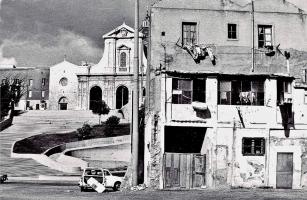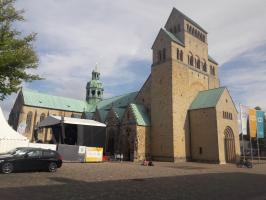ST. MARY'S BASILICA IN KRAKOW

St. Mary's Basilica is a classic example of Gothic architecture in Poland. It was built between the end of the 13th century and the beginning of the 15th century, on the foundations of an earlier Romanesque church, which was erected in the early part of the 13th century. It has a three aisle basilica-like body.
The façade is framed by two characteristic towers: the bugle tower (81 m) and the bell tower (69 m).
The famous bugle call is played every hour from the higher tower.

ALTARS BY THE PILLARS
By the pillars, separating the main nave from the side aisles, and in the side aisles themselves, there are Baroque altars founded in the second quarter of the 18th century by the archpriest Jacek Augustyn Lopacki. They were made of black marble from Debnik. The 5 altar paintings were commissioned from the famous Venetian painter Giambattista Pittoni: 'Annunciation' (9), 'Martyrdom of St. Sebastian* (6), 'Adoration of the Magi (4), Vision of St. Philip Nereus' (1) and 'St. Mary Magdalene' (3). However, the painting at the altar of St. Jerome and St. Augustine (2) was painted by Dominik Estreicher.
ALTAR OF ST. ANNE (5)
In the central space of the late-Baroque black marble altar, commissioned by the Foundation of Fr. Jack Lopacki, there is a 17th-century painting depicting Our Lady with her mother St. Anne, the infant Jesus and St. Nicholas. The scene is mounted in a frame made of silver-plated metal from the turn of the 17th and 18th centuries.
ALTAR OF ST. JOSEPH (7)
The painting 'St. Joseph with the Child', a work by Sebastian Woytowicz dated 1629 with alate-Baroque silver-plated dress in a metal frame was placed in the black marble altar that was commissioned by Foundation of Fr. Jacek Lopacki. In the oval finial of the medallion there is an image of St. James the Elder.
ALTAR OF ST. STANISLAUS (8)
The gilded Baroque altar of St. Stanislaus dates from 1675. The central scene is a depiction of one of the miracles performed by St. Stanislaus; the resurrection of Piotrowin. On the sides there are statues of St. Gregory and St. Ambrose, and in the upper part there is a bas-relief sculpture depicting the martyrdom of St. Stanislaus. On the right side of the altar there is a painting of Our Lady with the Child Jesus in a frame decorated with angels and a gothic baptismal font in the shape of a chalice made of bronze in the 4th century by master Ulric.
ROOD ARCH (10)
In the rood arch, separating the nave and the chancel hangs the crucifix from the Passion, group funded by Jerzy Turzon before 1512, and made by a student or follower of Veit Stoss. The present rood arch was designed by Jan Matejko and made by Tadeusz Blotnicki. The arch is supported by busts of angels holding shields with the coats of arms of Poland and Lithuania.
CIBORIUM (11)
The Renaissance ciborium was made between 1551 and 1554 by the sculptor and architect Giovanni Maria Mosca, known as Padovano.
Behind the tabernacle there is a painting Polish Saints Adoring the Crucified Christ, and slightly above there are bas-relief sculptures of angels. In the upper part there are circular decorations depicting the Madonna and Child and three prophets.
ALTAR OF THE HOLY CROSS (12)
A stone crucifix funded by Henryk Slacker and sculpted by Veit Stoss at the end of the 15th century was incorporated into the Baroque altar of the Holy Cross erected in 1735. The background is made of a silver metal sheet with a view of Jerusalem. Just below the crucifix there is an image of Our Lady of Sorrows, and beneath it, in a golden chest, there are the relics of St. Theodore wrapped in a banner.
CHANCEL (13)
The interior of the chancel is decorated with polychromy, designed by Jan Mateiko. Painted walls feature figures of angels playing instruments or holding banners with the text of the Litany of Loreto. The vaulted ceiling imitates a starry sky.
On both sides of the chancel there are canopied stalls.
In 1635, bas-relief sculpted backrests with the scenes from the life of Christ and Mary, were added by artist Fabian Möller.
ST. MARY'S ALTAR BY VEIT STOSS (WIT STWOSZ)

The altar of the Dormition of the Blessed Virgin Mary is one of the most outstanding works of late Gothic wood sculpture. Work on the altar continued from 1477 to 1489. It was founded by the townspeople of Krakow and measures 11x13 metres, and the height of the life-like statues is about 2.7 metres.
The altar was made of oak (the structure) and linden (the sculptures). The altarpiece is a pentaptych - it has 5 wings. It consists of a central part with carved figures, a pair of movable inner wings and a pair of fixed outer wings. The predella shows the Tree of Jesse - an artistic representation of the genealogy of Christ (A).
The open cabinet illustrates the mysteries of Mary's seven joys: The Annunciation (B), the Nativity of Jesus (C), Homage of the Magi (D), the Resurrection (E), the Ascension (F) and Pentecost (G). In the centre, the scenes of the Dormition of the Blessed Virgin Mary (H) and the Assumption (I) are presented. The altar is topped with a scene of the Coronation of the Blessed Virgin Mary (J) and statues of St. Stanislaus (K) and St. Adalbert (L).


























